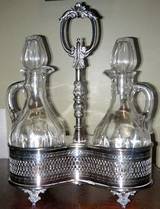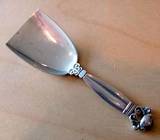Pricing Guides & Dictionary of Makers Marks for Antiques & Collectibles

Q&A ON RESEARCHING MARKS ON
ITALIAN DIAMOND GOLD RING - AUSTRIAN-HUNGARIAN SILVER BROOCH WITH PEARLS – GILT FISH SLICE SET
See more examples
ITALIAN GOLD RING WITH DIAMOND
In this instance, These AL initials refer to Alessandria, a region in Italy where many accomplished Jewelers & Silversmiths had set up their operations since the late 18thC to Present.
The number 1772 is probably the maker's registration number, but these records are not available for all Artisans and we could not find any specific matches for this particular number. If there are any other initials for the actual maker, please let us know. However, in most cases, this is often less significant since many of these fine pieces were made to order for a client or as a one-off piece for display and sale at their Retailer's shop.
As I am sure you know, the 750 refers to its precious metal content. If Gold, this translates to 18K in the "Thousands" notation used in several European countries, i.e. 75%.
AUSTRIAN - HUNGARIAN SILVER BROOCH WITH PEARLS
The style of this Brooch is characteristic of the region during that period and has some elements of Art Nouveau, although not strictly speaking, and incorporates various materials, incl. Pearls and Enamels, with elaborate detail.
The AM initials are those of the Jeweler or a Retailer's. There were several registered and/or documented Jewelers & Silversmiths with these initials during that time in the region, so we are not certain of the exact match. Here is a list of Austrian Jewelers & Silversmiths with these same initials who also worked during that time (I have only listed those that are the most likely to have made your piece):
- Albert Maderak - ca 1910s - 1929
- Alfred Mayer - ca 1905 - 1930
- August Menze - ca 1898 - 1922
- Adolf Messinger - ca 1902 - 1924
- Abraham Metzger - ca 1894 - 1924
- Ambrose Moritz - ca 1895 - 1924, and
- Anton Müller - ca 1909 - 1924
SILVER MARKS ON STERLING SILVER SPOONS
Here is how to read these marks, from left to right as pictured in your photo:
- CGH - maker's mark for C.G. HALLBERGS GULDSMEDS, AB[Guldsmeds is a generic term for Gold- or Silver-smiths alike, and "AB" is the equivalent of Inc], in business ca 1913 - 1982
- Three Crowns and letter S - Hallmark for "Sterling" in Sweden since 1912 to Present (see our "Recognizing Country Hallmarks" page through our EXTRA HELP section)
- Male Head mark - Hallmark for the city of Stockholm (depicts Saint Erik)
- S8 - Date mark, in this case for the year 1944
SILVER-PLATED CRUET SET
The sideways mark to the very right, which is only partially visible, probably reads EP for Electro-Plated. To learn more, please see our articles STERLING SILVER & SILVERPLATED ANTIQUES: Understanding Sterling Silver or Silverplate and related terms and SILVER & SILVERPLATE DURING THE VICTORIAN ERA.
SILVER SUGAR SHOVEL SPOON
The "e" letter in this exact format is the Date Letter notation used in Holland and in this case refers to the year 1864, which dates your item. We can see no maker's mark, but that's not unusual on items made for export from that country as it was probably made to order (subcontracted) for some unknown Dutch Exporter or a US or UK -based Importer in mid-19thC.
ART NOUVEAU BRASS DESK SET MARKS
The top three letters are DEP. In general, these initials stand for the French word DEPOSE, which means "Registered", but it was also used on items made in Germany, where these initials have the same meaning and refer to the word DEPONIERT ("registered" or "copyright"). In my opinion and based on the distinct style of this item, I believe it originates from France.
Although not precisely known as to its exact maker, the characteristic style, age, origin and utility of this item make it desirable to collectors of Desk Sets. To see some representative values on related items sold at auction from various known and unknown manufacturers, please use our Antiques Price Guides and search for "Brass Desk Set".
SILVER TEAPOT MARKS
This item was actually made by CRESCENT SILVERWARE MFG Co., who were later acquired by KIRK & SON. They used this mark between 1922 and 1977, so your Teapot was made ca mid-20thC. It is silver-plated on Copper.
MARK ON SILVER TEA INFUSER
As you know, at that time, and in fact until very recently, Precious Metals such as Gold, Platinum or Silver were the "guarantee" of a country's Currency Reserves
(similar to the Federal Reserve in the US today), and after almost every war, there were massive nation-wide inventories taken to assess the value of Precious Metals
reserves in the country in order to print money that would be internationally recognized and assured, known as the "Gold Standard" Monetary System. Items
inventoried in this manner were pucnhed with a
BRONZE FLATWARE
Your Set probably dates ca 1980s - 1990s, it is not antique, but still quite elegant and exhibits some Modernist (minimalist) design elements. The outer box was probably made to order (outsourced), so in this case the "LION" text-mark is not relevant, but typical of Thai manufacturers' names.
To use our huge database of Silver & Jewelry makers' marks and hallmarks, including marks on other Precious metals, Pewter and other collectible Metalware, please see our Silver & Jewelry or Pewter Marks Identification Guides.
To find prices and determine values for your antiques & collectibles, including Jewelry & Silver or Pewter, please see our Antiques Price Guides with millions of examples of items sold at auction.


